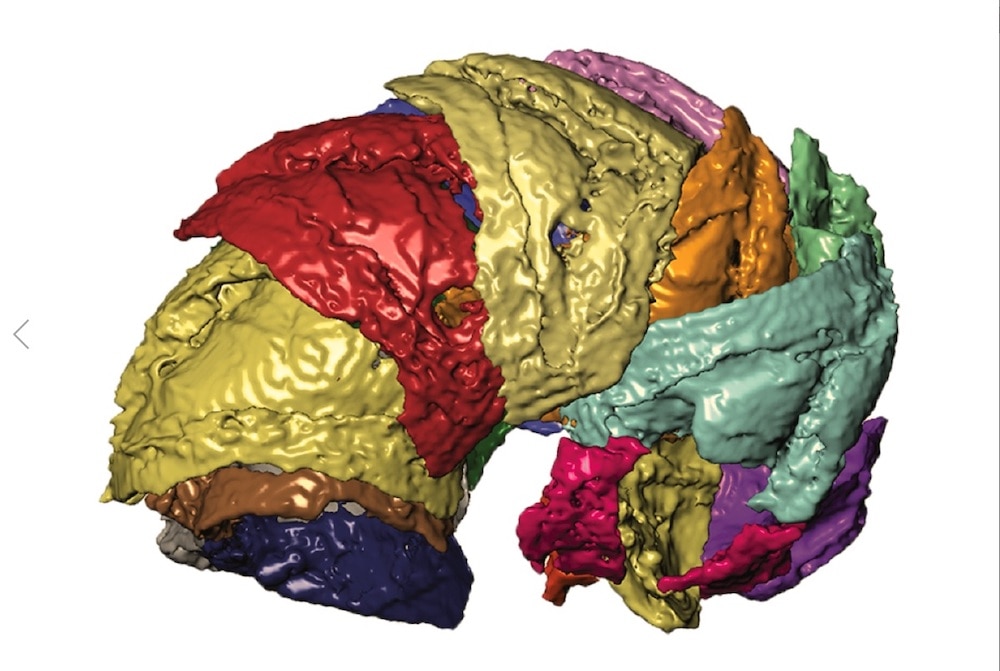Create a free profile to get unlimited access to exclusive videos, sweepstakes, and more!
Virtual models are bringing ancient, armored, Dune-like worms back to life (sort of)
You can't escape bugs, even in virtual worlds.

In his "Allegory of the Cave," Plato describes a group of people chained to a cave wall, observing the world through only the flickering shadows it casts. It provides the observers an incomplete picture of the world, one which is two-dimensional and necessitates speculation.
This is the sort of view we have of the deep past. Paleontologists are tasked with building a picture of Earth’s history out of the thin fossilized shadows it leaves behind. Those fossil remains of extinct organisms give us a small glimpse into the animals who lived and died long before humans showed up. But those preserved tissues, often incomplete, provide a picture which is necessarily only part of the truth. A thin shadow of what they really were, leaving us to fill in the gaps through inference and informed speculation.
However, advances in technology coupled with especially well-preserved specimens allow scientists to leave the proverbial cave and gain a clearer picture. A recent study by Dr. Sarah M. Jacquet from the Department of Geological Sciences at the University of Missouri, and colleagues, utilized micro-CT scans to build models of extinct armored worms — known as Machaeridians — in stunning 3D. Their findings were published in the journal Papers in Paleontology.
“The CT scans take thousands of X-rays that represent cross-sectional slices through the specimen. Then we imported the images into a 3D software to manually highlight features we are interested in on each image. Once we highlight each plate, we can create the virtual 3D model,” Jacquet told SYFY WIRE.
Jacquet was first turned on to Machaeridians by their advisor during their PhD project. Some of the specimens used in this work were originally described by Dr. Brian Johnson in 1981. They are found in limestone blocks and are isolated using a weak acid, no stronger than vinegar, which dissolves the limestone leaving the silicate fossils behind. Jacquet looked through hundred of boxes, mostly containing disarticulated individual plates, looking for complete animals.
Articulated specimens are exceedingly rare. Out of those hundreds of boxes, Jacquet found only three new articulated armored worm fossils to add to Johnson’s earlier work.
“We were fortunate that these worms were preserved the way they were, having been replaced by silica. Because of this, we could scan the fossils using a specialized CT-scanner, one at Sydney University and one at the University of Missouri. Once we had the scan, it was a matter of putting these X-ray projections into a 3D software to create the virtual relocation of the specimens.”
The specimens they used were remarkably complete but had the benefit of being supplemented by loose induvial plates which provided additional context for the overall models. The team was able to build models which showed the way plates interlocked along the length of the body providing protection from attacks.
Most modern worms avoid attacks by burrowing into the ground, but these external structures provided additional protection from predators.
“They are almost like the underwater equivalent of spice worms from Dune, except on a much smaller scale,” Jacquet said. “Based on the arrangement of the plates for the species we observed, the armor assembly was probably an effective deterrent against crushing, biting, and drilling predatory attacks.”
The body plans of these armored worms closely resemble modern animals like millipedes, pill bugs, and pangolins which coil into protective balls to avoid being eaten, though this sort of strategy was rare during the time period. Similar structures are present in modern, unrelated organisms, suggesting convergent evolutionary processes developed independent body plans for combating similar predatory challenges.
Now that scientists have clear 3D models of these animals, they are looking to develop images of their movements to better understand how they navigated ancient ocean-bottom environments.
“We want to explore how the plate rows articulate, and how the armor reacts to different types of stress, which might tell us more about how effective it was in protecting these worms from certain predators,” Jacquet said.
Modern technologies are allowing us to take disparate, unconnected pieces from the fossil record and place them together in context to build a more robust picture. Moreover, 3D modeling allows for the dissection of individual specimens — which previously required the destruction of the fossils — unlocking internal mechanisms and interrelations.
Ancient animals recovered from underground sediments are finding their way not only to the surface but into virtual spaces where scientists are able to translate them from individual puzzle pieces into 3D organisms which more-closely reflect the animals they once were.
While Jurassic Park imagined pre-historic resurrections via genetic manipulation, real-world scientists are bringing ancient animals back to life inside digital spaces. Your ticket to prehistoric lands might exist not within the reconstructed real world, but in virtual landscapes populated by armor-plated subterranean worms.
At least digital animals can’t eat us alive when we visit them.



























